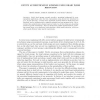135 search results - page 18 / 27 » Authentication and Key Agreement Protocols Preserving Anonym... |
CRYPTO
2006
Springer
13 years 11 months ago
2006
Springer
In a seminal paper, Feldman and Micali (STOC '88) show an n-party Byzantine agreement protocol tolerating t < n/3 malicious parties that runs in expected constant rounds. H...
DAM
2006
13 years 7 months ago
2006
Abstract. Artin's braid groups currently provide a promising background for cryptographical applications, since the first cryptosystems using braids were introduced in [2, 3, ...
SIGMOD
2004
ACM
14 years 7 months ago
2004
ACM
Secure communication guaranteeing reliability, authenticity, and privacy in sensor networks with active adversaries is a challenging research problem since asymmetric key cryptosy...
SCN
2010
Springer
13 years 6 months ago
2010
Springer
We introduce a protocol, that we call Human Key Agreement, that allows pairs of humans to establish a key in a (seemingly hopeless) case where no public-key infrastructure is avail...
CRYPTO
2005
Springer
14 years 1 months ago
2005
Springer
Abstract. We propose a way to establish peer-to-peer authenticated communications over an insecure channel by using an extra channel which can authenticate very short strings, e.g....

